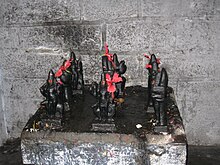
The navagraha are nine heavenly bodies and deities that influence human life on Earth according to Hinduism and Hindu astrology. [1] The term is derived from nava ( Sanskrit: नव "nine") and graha ( Sanskrit: ग्रह "planet, seizing, laying hold of, holding"). The nine parts of the navagraha are the Sun, Moon, planets Mercury, Venus, Mars, Jupiter, and Saturn, and the two nodes of the Moon. [2]

The term planet was applied originally only to the five planets known (i.e., visible to the naked eye) and excluded the Earth. The term was later generalized, particularly during the Middle Ages, to include the sun and the moon (sometimes referred to as "lights"), making a total of seven planets. The seven days of the week of the Hindu calendar also corresponds with the seven classical planets and related day names of European culture and are named accordingly in most languages of the Indian subcontinent. Most Hindu temples around the world have a designated place dedicated to the worship of the navagraha.
List
| No. | Image | Name | Western equivalent | Day |
|---|---|---|---|---|
| 1. |

|
Surya | Sun | Sunday |
| 2. |

|
Chandra | Moon | Monday |
| 3. |

|
Mangala | Mars | Tuesday |
| 4. |

|
Budha | Mercury | Wednesday |
| 5. |

|
Bṛhaspati | Jupiter | Thursday |
| 6. |

|
Shukra | Venus | Friday |
| 7. |

|
Shani | Saturn | Saturday |
| 8. |

|
Rahu | Ascending node of the Moon | |
| 9. |

|
Ketu | Descending node of the Moon |
Music
Muthuswami Dikshitar (1776–1835), a Carnatic music composer from southern India, composed the Navagraha Kritis in praise of the nine grahas. [3] Each song is a prayer to one of the nine planets. The Sahitya[ disambiguation needed] (lyrics) of the songs reflect a profound knowledge of the mantra and jyotisha sastras.
See also
References
- ^ Sanskrit-English Dictionary by Monier-Williams, 1899
- ^ "Dikshitar: Navagraha". www.medieval.org. Retrieved 2020-06-12.
External links
-
 Media related to
Navagraha at Wikimedia Commons
Media related to
Navagraha at Wikimedia Commons
